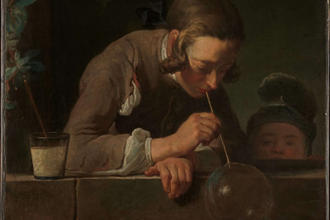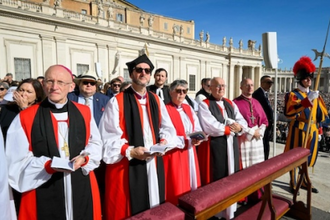Gospel in Art: You shall call his name Jesus

Christ Salvator Mundi by Quentin Massys, 1520. Oil on panel. © Koninklijk Museum voor Schone Kunsten, Antwerp, Belgium
Source: Christian Art
Gospel of 8 November 2025
Matthew 1:18-23
Now the birth of Jesus Christ took place in this way. When his mother Mary had been betrothed to Joseph, before they came together she was found to be with child from the Holy Spirit. And her husband Joseph, being a just man and unwilling to put her to shame, resolved to send her away quietly. But as he considered these things, behold, an angel of the Lord appeared to him in a dream, saying, 'Joseph, son of David, do not fear to take Mary as your wife, for that which is conceived in her is from the Holy Spirit. She will bear a son, and you shall call his name Jesus, for he will save his people from their sins.'
All this took place to fulfil what the Lord had spoken by the prophet:
'Behold, the virgin shall conceive and bear a son,
and they shall call his name Emmanuel' - which means, God with us.
Reflection on the painting
We had today's Gospel reading earlier this week. Twice this week we have the same reading. In our Catholic Lectionary for Ordinary Time, the weekday readings are arranged in a two-year cycle: Year I for odd-numbered years and Year II for even-numbered years, where mainly the First Readings differ. The Gospels, however, largely follow a one-year cycle that repeats every year. Because of this, there can sometimes be overlaps or repetitions, even within the same week. These repetitions aren't accidental. They allow us to linger over very key moments of the Gospel and go deeper.
Today's Gospel gives the child to be born two names: Jesus and Emmanuel, each rich with meaning. In the Semitic world, names revealed a person's identity and mission. Jesus means "the Lord saves," for, as the Gospel tells us, he is the one who will save his people from their sins. Emmanuel means "God is with us," expressing the mystery of God dwelling among us. These two names reveal who this child truly is: God present in our midst, not as a distant ruler but as one who comes to heal, forgive, and reconcile.
So for today's artwork we simply look at a portrait of Jesus. The Salvator Mundi ("Saviour of the World") image is one of the most enduring devotional types in Christian art. It portrays Christ frontally, often shown half-length, raising his right hand in blessing while holding a cross or crystal orb in his left. Unlike narrative scenes from Christ's life, these are intimate, iconic portraits, mainly meant for private devotion rather than public altarpieces. So they are usually quite small in size. They present Christ not in action but in quiet majesty. We see Jesus looking directly at the viewer, inviting contemplation and personal encounter.
Our version by Flemish painter Quentin Massys beautifully combines the devotional stillness of an icon with the naturalism of Flemish portraiture: Christ's gaze is calm yet searching, his blessing hand rendered with meticulous realism, and the cross reflects tiny glimmers of light symbolising the world he redeems. Quentin Massys (also spelled Metsys) was a pioneering Flemish painter, bridging the late Gothic and early Renaissance styles in the Low Countries.
LINKS
Gospel in Art: https://christian.art/
Today's Reflection: https://christian.art/daily-gospel-reading/matthew-1-18-23-2025-4/
and
Video: The Art of Remembrance - From The Monuments Men to The Last Post: www.indcatholicnews.com/news/53644


















